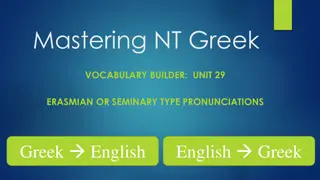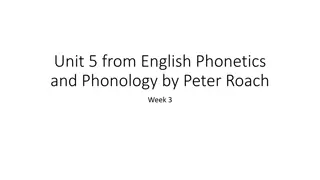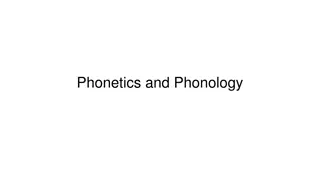Greek Phonology Exercises and Resources Overview
Explore Greek phonology exercises, resources like Wikipedia and Howe Library online, and key PIE sound transformations in Greek. Consult resources for laryngeal theory, Ancient Greek phonology, and Proto-Greek language.
Download Presentation

Please find below an Image/Link to download the presentation.
The content on the website is provided AS IS for your information and personal use only. It may not be sold, licensed, or shared on other websites without obtaining consent from the author.If you encounter any issues during the download, it is possible that the publisher has removed the file from their server.
You are allowed to download the files provided on this website for personal or commercial use, subject to the condition that they are used lawfully. All files are the property of their respective owners.
The content on the website is provided AS IS for your information and personal use only. It may not be sold, licensed, or shared on other websites without obtaining consent from the author.
E N D
Presentation Transcript
Fortson 12: Greek Hints for Exercises
wikipedia helps Fortson usually supplies what we need, but the largyngeals are explained more fully and perhaps more understandably (in charts) on wikipedia s laryngeal theory page: https://en.wikipedia.org/wiki/Laryngeal_theory#H- loss_adjacent_to_other_sounds In addition, the Wikipedia page on (Classical) Ancient Greek Phonology helps: https://en.wikipedia.org/wiki/Ancient_Greek_phonology Wikipedia s Proto-Greek page also helps: https://en.wikipedia.org/wiki/Proto-Greek_language I m going to feel free to consult those for these exercises, and you should too.
Another resource Go to Howe Library online. Go to research databases : it s an option on the very front page when I go to Howe Library. You ll probably have to sign in at some point. Go to the i s and find Indo-European etymological dictionaries online There you can use Beekes for Greek (or others for some other languages). This is a very important (and very expensive) database for PIE studies which you should know about. Bookmark it.
12.1 the fate of these PIE sounds in Greek a. *w see 12.22 second paragraph b. *h2 12.23 what about when it was not vocalized : when it was a consonant? see 12.22 does Wikipedia add to this? c. *kw centum language changes and 12.15, 12.16 d. *s 12.18: there are different environments (with different outcomes) to describe e. *dh centum language and 12.13 f. *m 12.20: more than one outcome to describe
12.2 a. *h1le-h1ludh- come (perfect stem) these are laryngeal consonants before a liquid remember what you did for 1b: the outcome is different word-initially does the second h1 laryngeal count as word-initial? or was it treated as *eh1, in which case, in PIE, the laryngeal dropped out and compensatory lengthening occurred? Beekes seems to argue it s the second option. Beekes says: perf. ('Attic reduplication' from * h1le-h1loudh-, with metrical lengthening), ptc. ( ) (epic), (post-Hom.) b. *deh3-rom remember coloring and lengthening remember outcome of m you described in 12.1f.
c. *h2woideh2- song: as in ode or tragedy or melody *h2w- = word-initial consonant laryngeal + consonant resonant (abbreviated as HC ) see chart in Wikipedia laryngeal theory article under Greek triple reflex v. schwa consonant w (12.22): it has two possible outcomes, depending on the dialect: well, it may be that some dialects represent it, while others do not, which is not necessarily two different outcomes, where the glide is not represented but stilll counts as a consonant for metrical purposes. remember coloring and compensatory lengthening for *eh2 d. *gwelbhus womb (remember when we did this one in Sanskrit at 11.1a? it was o-grade there: here the e-grade affects the labiovelar s outcome) 12.15 for the labiovelar 12.13 for the aspirated voiced stop e. *tn tos stretched (could taut be related? Wiktionary seems to say not directly, but that taut was probably influenced by the ancestor of this word) syllabic resonant n
f. *bhnghus thick : think of pachyderms, which has thick skin two aspirated voiced stops > first change them into Greek outcome, > then apply Grassman s syllabic resonant n g. *h2weh1ti blows : in the Vedic sample, we had a cognate vayur in the sixth line: this is Greek whatever you did with 2c. above should apply to *h2w h. *h2i-h2eus-oh2 I stay the night the *ih2eu looks like inter-vocalic laryngeal loss *-eusoh2 is a between-vowels s: see 12.18 near the start *-oh2: laryngeal loss + compensatory lengthening
i. *h2enh1mos : cognate with Latin animus PIE coloring for *h2e *h1 is treated in 12.23 j. *bheidhoh2 I trust first, treat the voiced aspirates to make them the Greek outcome, then apply Greek Grassman s Law k. *newos new 12.22 l. *n g n gland : adenoids comes from this 12.21 for the syllabic nasal 12.15 for the labiovelar
12.3 The task is to explain why Indic Grassman s law is different from Greek Grassman s law Another way to put it is that the task is to show that although the change which Grassman saw is similar in both Indic and Greek, it did not occur already in PIE, but rather was an independent later change in Indic and an independent later in Greek. Try looking up Grassman s law on wikipedia for some hints. Fortson doesn t say so, but this question is linked to exercise 5 below.
12.4 we know the labiovelars were all lost in Greek. could what they left behind then assimilate to the nasal when followed by a nasal? or is something else happening?
12.5 The point here is that the s is acting as an aspirate and so Grassman s law still applies, right? I am pretty sure that in b, we are being asked to construct a future of ekho based on the pattern of grapho (present) and grapso (future). BTW, b is not asking you to construct a PIE future, but rather a Proto-Greek future form. Found on Wikipedia s Proto-Greek phonology page: Grassman s Law also postdates the change of /s/ > /h/, as it affects /h/ as well: kh "I have" < *hekh- < PIE *se - oh , but future heks "I will have" < *heks- < Post-PIE *se -s-oh . the form in c seems to violate Grassman s Law. But what happened to inter-vocalic s? If that happened before the change of Grassman s law occurred, then Grassman s Law would not apply. I think this is essentially asking you to figure out the temporal order in which the changes occurred, given the evidence.
12.6 a. Seems rather obvious. Am I missing anything? I don t think so. b. I m not sure where this is in the chapter, but meter is explained very very briefly in Fortson. Here is another explanation of what is needed here: a syllable is long in Greek if it has a long vowel or if it is followed by two consonants (which can be in the next word). a syllable is short in Greek if it has a short vowel AND is not followed by two consonants. so phile hekure looks like it is 5 shorts: short short short short short BUT that is absolutely unacceptable in Homer s dactylic hexameters: it never happens. There can NEVER be three shorts in a row in Homer. There can be two shorts in a row, but not three. So use the two consonant rule above to figure this out: how can there be felt to be two consonants in a row in phile hekuros?
12.7a So first off, notice that in every case, some consonant is missing from the form that results. Remember what happened in PIE when a laryngeal dropped out? Something happened to a vowel to compensate. Note that sometimes sounds switch places : that is called metathesis. What undergoes metathesis here? This outcome of s should be included in 12. 18 and 12.19; the outcome of the loss of m or n should be included in 12.20. Found on Wikipedia s Proto-Greek Phonology page: A change that occurred between Proto-Greek and recorded Greek: Loss of s in consonant clusters, with compensatory lengthening of the preceding vowel (Attic, Ionic, Doric) or of the consonant (Aeolic): * smi "I am" > mi, e mi or mmi. How does a consonant lengthen ? it geminates (i.e. it doubles: here the mmi form shows that). A change that occurred after Proto-Greek led to Mycenaean Greek, but before later Ancient Greek: Loss of /n/ before /s/ (incompletely in Cretan Greek), with compensatory lengthening of the preceding vowel."
12.7b, c, and d b. Go back to the verb chapter to do this. c. look at what happened in 12.7a to *ksenwos: it changed to Greek kseinos. This is parallel to that case. d. by vocalism must be meant the vowels: theou-des vs. theo-trephes.
12.8 Go back to 5.16 for Fortson s ideas on the reconstruction of the middle endings. Feel free to mine the resources on wikipedia mentioned in a slide near the beginning. Note that this problem is asking you to trace the stages that Fortson s views indicate must lie between the PIE verb and the actually occurring form he gives you from Greek.
12.9 Homeric meter should consist of nothing but dactyls and spondees: dactyl is Long-short-short, and spondee is long-long In practice, what that means for you is that there should never ever be 1) three shorts in a row in a Homeric line or 2) a single short between two longs immediately on each side of it or 3) two longs in a row with shorts immediately on either side of it. What is short in Greek? any vowel that 1) doesn t have a macron above it (the bar in ) AND 2) does not have two consonants after it (that includes any consonant(s) that starts the next word) What is long: any vowel with a macron above it (the bar in ), diphthongs (well, just about all), and any vowel that has more than one consonant in a row after it (including any consonant(s) that starts the following word) So, applying those rules, the following should be how the lines fortson gives us scan: a. orea niphoenta short o- short -re- short a short ni- short -pho- long ent- short a short short short short short long short = UUUUU-U (using u for short and for long: Fortson uses the correct symbols: microns and macrons). b. eban oikonde short e short ban long oi long kon short de short short long long short c. es diphron arnas long es long diph- short -ron long ar- short -nas long long short long short d. parekh i short pa short re- long kh i short short long Compare those to what Fortson tells you that the lines scan as: he is correct about it all, but the above is what it seems like if you don t know the hidden features that lie beneath the surface. The meter preserves traces of the proto- forms even after those traces are no longer visible in writing.
12.9 hints a. look up in Wiktionary: what does the PIE ancestor look like? if the Greek had kept the same consonants, how would that affect the meter? b. look up in Wiktionary: do the same as you did with a. c. look up (genitive ) in Wiktionary: do the same. d. use the form of the verb that existed in Pre-Greek according to 5b: does the meter work better?
12.10 We are expected to explain the z, really, not the rest of the word, which is much easier. I think that Fortson wants us to notice the Proto-Greek form *bheront-ya in 6.71 and apply it to arguropeza But we also have to notice that in arguropeza, there is a z, and then to go looking through the chapter until we chance upon a likely explanation for that z. Given that pezos means footed, it is likely from ped- foot in Greek. So the z could be from * d-ya-? Now check out 12.26. That should give you the pieces you need. BTW, it looks as if Wiktionary reconstructs a proto-greek *pedd- instead of *pedy- for arguropeza. Hmmm.
12.11 So it looks as if the d and the b are not in the proto-forms of these words. So what happened? Think about where an n is pronounced in the mouth and where a d is pronounced (I m talking about roughly the same sounds as English /n/ and /d/ rather than some other sounds. Then think about where /m/ and /b/ are pronounced. This should lead you to conclude that the same thing is happening in both cases. This is called epenthesis: https://en.wikipedia.org/wiki/Epenthesis























